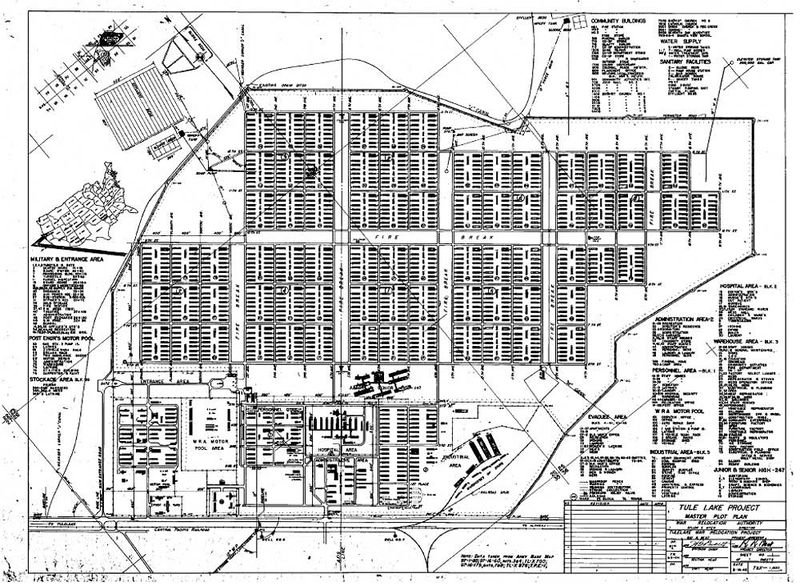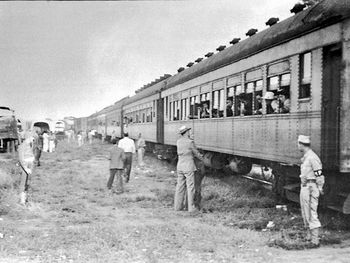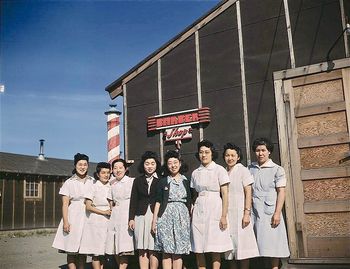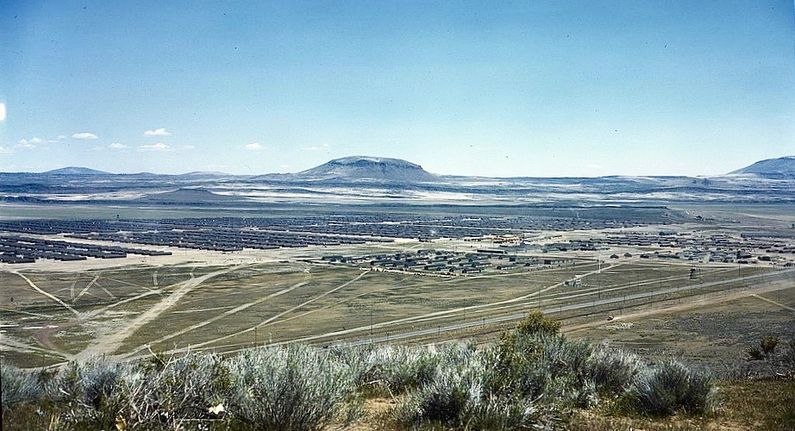Tule Lake War Relocation Center
|
HistoryConstruction began on 15 Apr 1942 on the Tule Lake Relocation Center. On 1 Jun 1942, the center became the Tule Lake War Relocation Center run by the civilian War Relocation Authority (WRA). The relocation centers were not considered by authorities to be either concentration camps or internment camps but the perception was otherwise. Barbed wire fencing enclosed most of the of the living area, the guard towers with searchlights and the military police were always visible. ProblemsFrom the start, the Tule Lake Relocation Center had problems. Within the first year, there was a mess hall strike to protest inadequate food, a farm strike, and a general strike. Additional problems arose when the WRA decided to segregate the "disloyal" from the "loyal" with a questionnaire. Those who answered "no" to the two loyalty questions and those who refused to answer the questionnaire at all were considered "disloyal". Initially, some of those who failed to answer the questionnaire were arrested and jailed in nearby jails and Camp Tulelake which had been the old Tulelake Civilian Conservation Corps (CCC) camp. Tule Lake had the highest proportion of disloyals of all the relocation centers. This led to a decision to consolidate all of the disloyals at Tule Lake and to change Tule Lake WRC into a maximum security segregation facility. Tule Lake Maximum Security Segregation Facility In the summer of 1943 the Tule Lake Relocation Center was converted into a maximum security segregation facility to house those Japanese Americans considered disloyal. The evacuees at Tule Lake who were considered loyal were to move to other relocation centers to make room to consolidate the disloyals at Tule Lake. Some 6,000 evacuees moved, but some 4,000 loyals chose to stay. New facilities were constructed to house many of the new arrivals and to improve security at the segregation facility. Tule Lake became the largest WRC and by early 1944, over 18,000 people were housed there. Additional troops were assigned to the Tule Lake WRC. A lighted 6-foot-high chain link fence, topped with barbed wire and thirteen more watchtowers were added around the relocation center perimeter. A warning fence 50 feet in from the perimeter fence was put in place. Fences and watchtowers were also built around the outlying farm fields of the center and a more secure entrance, a larger military police compound, a motor pool, and other facilities were built to the west of the original military police compound, which was converted to staff housing. A new military police compound housed an entire battalion (31 officers and 900 enlisted men), eventually, some 1,200 soldiers were assigned to the WRC. The added security features made the facility far more secure but also gave rise to the specter of an American concentration camp that persists today.
DiscontentIn October 1943 a protest over a widows compensation for the accidental death of her husband resulted in an agricultural worker strike. Workers from other relocation centers were brought in to harvest the crops and discontent spread. On 1 Nov 1943, a large crowd assembled in the administration area to protest. Military police used jeeps mounted with machine guns and tear gas to break up the crowd and began the arresting suspected leaders. On 14 Nov 1943 martial law was declared and the military police took over control of the center from the WRA. A fence and five watchtowers were constructed between the administration and evacuee residential areas. To provide further isolation for the more militant residents, a 250' by 350' stockade was built inside the center. The stockade was enclosed by fences and four watch towers, and a jail. Within the stockade, there were barracks, a mess hall, and a latrine. Over 350 dissident leaders were arrested and placed in the stockade and 1,200 others were sent to Department of Justice internment camps. On 11 Jan 1944, the center residents voted to end the protest and martial law was lifted on 15 Jan 1944. On 23 May 1944, control of the stockade was returned to the WRA. On 24 May 1944, a guard shot and killed a resident. In June 1944 the general manager of the Business Enterprise Association was found murdered. RepatriationBecause a number of evacuees at Tule Lake had renounced their American citizenship and could not be repatriated to Japan or released back into the U.S. until their cases had been reviewed, the Tule Lake WRC continued to operate until March 1946. The remaining 400 evacuees were transferred to the Crystal City Internment Center in Texas. The Tule Lake facilities closed on 20 Mar 1946 when the last evacuees departed. Residental Blocks The residential blocks were divided into eight wards, each bounded on all sides by 200' wide firebreaks. Most wards comprised nine residential blocks; the exceptions were Ward 6, which had only six blocks, and Ward 8, on the east side, which was composed of 13 blocks. The initial 40 residential blocks built each had thirteen 20' by 100' barracks, a 40' by 100' mess hall, a recreation building, a men's latrine and shower, a women's latrine and shower, a 20' by 50' laundry, and an ironing room. Later, another women's latrine and shower building were added to each of these blocks. These buildings were all temporary military style Theater of Operations (TO) structures of wood frame construction with tar paper covering the outer walls and roof. A later round of construction added Sixteen residential blocks that had combination men's and women's latrine and shower buildings and a combination laundry and ironing room. The change to a Maximum Security Segregation Facility added ten more of new type blocks, for a total of 66 residential blocks. Blocks were numbered sequentially but numbers 55 and 60-65 were not used.
Current StatusNow part of Tule Lake Unit, WWII Valor in the Pacific National Monument includes both the the Tule Lake Segregation Center and Camp Tulelake, which was first a Civilian Conservation Corps camp, then an additional facility to detain Japanese Americans, and finally a German prisoner of war camp.
See Also: Sources:
Links: Visited: No
| |||||||


